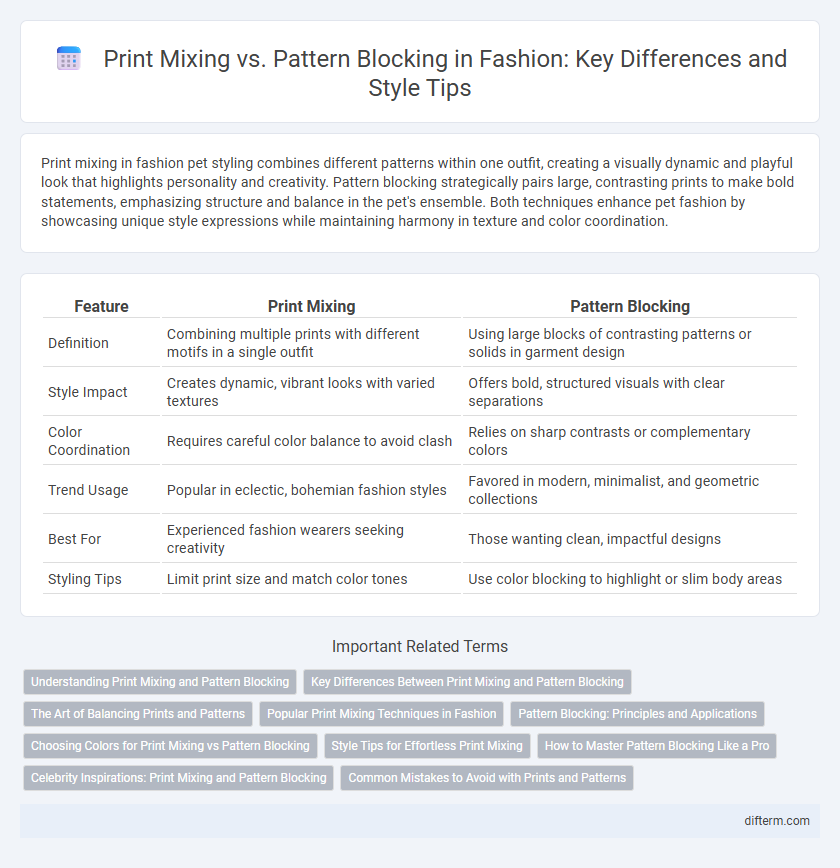Print mixing in fashion pet styling combines different patterns within one outfit, creating a visually dynamic and playful look that highlights personality and creativity. Pattern blocking strategically pairs large, contrasting prints to make bold statements, emphasizing structure and balance in the pet's ensemble. Both techniques enhance pet fashion by showcasing unique style expressions while maintaining harmony in texture and color coordination.
Table of Comparison
| Feature | Print Mixing | Pattern Blocking |
|---|---|---|
| Definition | Combining multiple prints with different motifs in a single outfit | Using large blocks of contrasting patterns or solids in garment design |
| Style Impact | Creates dynamic, vibrant looks with varied textures | Offers bold, structured visuals with clear separations |
| Color Coordination | Requires careful color balance to avoid clash | Relies on sharp contrasts or complementary colors |
| Trend Usage | Popular in eclectic, bohemian fashion styles | Favored in modern, minimalist, and geometric collections |
| Best For | Experienced fashion wearers seeking creativity | Those wanting clean, impactful designs |
| Styling Tips | Limit print size and match color tones | Use color blocking to highlight or slim body areas |
Understanding Print Mixing and Pattern Blocking
Print mixing involves combining different prints with similar color palettes to create a cohesive yet dynamic look, enhancing visual interest while maintaining harmony. Pattern blocking, on the other hand, uses bold, contrasting blocks of patterns or solids to create a striking, graphic effect that emphasizes shape and structure. Mastering both techniques requires an understanding of scale, color balance, and the interaction between prints and patterns to achieve a stylish and balanced outfit.
Key Differences Between Print Mixing and Pattern Blocking
Print mixing combines different prints such as florals, stripes, and polka dots within a single outfit to create a visually dynamic look, whereas pattern blocking involves wearing solid blocks of contrasting patterns for a more structured and bold appearance. Print mixing emphasizes eclectic combinations that often rely on color harmonies to balance diverse motifs, while pattern blocking focuses on clear-cut separation of patterns with defined boundaries to emphasize shape and form. Understanding these key differences helps fashion enthusiasts strategically choose between playful versatility and graphic impact in styling.
The Art of Balancing Prints and Patterns
Print mixing involves combining different motifs such as florals and stripes to create a visually dynamic outfit, while pattern blocking uses solid color blocks to contrast with printed fabrics, emphasizing bold shapes. Mastering the art of balancing prints and patterns requires attention to color harmony, scale proportion, and texture variation to avoid overwhelming the look. Key techniques include pairing prints with complementary palettes and using neutral tones as anchors to achieve stylish cohesion.
Popular Print Mixing Techniques in Fashion
Popular print mixing techniques in fashion include combining floral with stripes, pairing polka dots with animal prints, and layering geometric patterns with plaids to create visually dynamic outfits. Effective print mixing relies on coordinating color palettes and scale contrast to maintain balance and avoid visual clutter. This trend enhances versatility in styling, allowing bold, individualized fashion statements.
Pattern Blocking: Principles and Applications
Pattern blocking in fashion leverages contrasting geometric shapes and bold color blocks to create visually striking ensembles that emphasize structure and balance. Strategic placement of patterns enhances body contours and adds depth, making it a favored technique for designers aiming to craft modern, edgy looks. This method is widely applied in apparel, accessories, and footwear, enabling versatile styling that captures attention while maintaining cohesive aesthetics.
Choosing Colors for Print Mixing vs Pattern Blocking
Selecting colors for print mixing involves harmonizing contrasting shades to create a balanced yet dynamic outfit, often pairing complementary or analogous hues. Pattern blocking requires choosing distinct, solid color blocks that enhance the garment's silhouette and provide a bold, graphic contrast. Both techniques emphasize intentional color coordination to maintain visual coherence and style impact in fashion ensembles.
Style Tips for Effortless Print Mixing
Effortless print mixing involves balancing contrasting patterns like florals and stripes by unifying colors or scale to maintain harmony in an outfit. Opt for a dominant print paired with a subtler one to avoid visual overload and enhance overall cohesion. Incorporate solid-colored accessories or layering pieces to anchor the look and create seamless pattern transitions.
How to Master Pattern Blocking Like a Pro
Mastering pattern blocking requires a keen eye for color coordination and scale balance, ensuring bold prints complement rather than clash. Choose patterns that share a color palette or contrast in texture to create a cohesive yet dynamic outfit. Experiment with geometric shapes, stripes, and florals in varying sizes to achieve a visually striking, runway-ready look.
Celebrity Inspirations: Print Mixing and Pattern Blocking
Celebrity inspirations in fashion showcase bold print mixing and pattern blocking techniques, elevating outfit creativity and visual interest. Icons like Rihanna and Zendaya expertly combine florals with stripes or polka dots alongside geometric patterns, highlighting fearless style experimentation. These trendsetters influence designers to embrace clashing prints and vibrant contrasts, redefining modern wardrobe aesthetics.
Common Mistakes to Avoid with Prints and Patterns
Common mistakes to avoid with prints and patterns include ignoring scale and proportion, which can create visual chaos when mixing large and small prints improperly. Clashing color palettes often lead to an unharmonious look, so sticking to complementary or analogous colors is essential. Overloading an outfit with too many different patterns or prints without a unifying theme can overwhelm the eye and reduce overall style cohesion.
Print mixing vs pattern blocking Infographic

 difterm.com
difterm.com